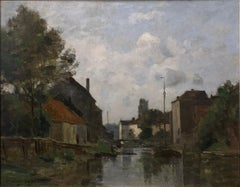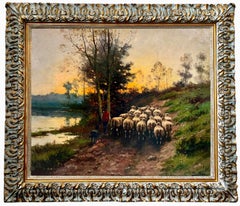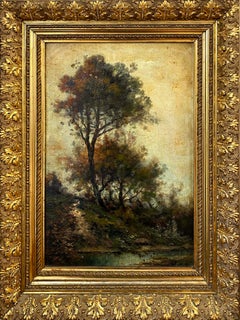Charles François Daubigny Paintings
French, 1817-1878
Charles-François Daubigny, (15 February 1817 – 19 February 1878), Daubigny was born in Paris, into a family of painters and was taught the art by his father Edmond François Daubigny and his uncle, miniaturist Pierre Daubigny. Initially Daubigny painted in a traditional style, but this changed after 1843 when he settled in Barbizon to work outside in nature. Even more important was his meeting with Camille Corot in 1852 in Optevoz (Isère). On his famous boat Botin, which he had turned into a studio, he painted along the Seine and Oise, often in the region around Auvers. From 1852 onward he came under the influence of Gustave Courbet. In London he met Claude Monet, and together they left for the Netherlands. Back in Auvers, he met Paul Cézanne, another important Impressionist. It is assumed that these younger painters were influenced by Daubigny. Daubigny's finest pictures were painted between 1864 and 1874, and these for the most part consist of carefully completed landscapes with trees, river and a few ducks. It has been said that when Daubigny liked his pictures he added another duck or two, so that the number of ducks often indicates greater or less artistic quality in his pictures. He was named by the French government as an Officer of the Legion of Honor. Daubigny died in Paris in 1878.(Biography provided by Graves International Art)
to
1
1
1
1
Overall Height
to
Overall Width
to
1
1
10
829
654
649
610
1
1
1
1
Artist: Charles François Daubigny
Bords de l'Yonne
By Charles François Daubigny
Located in Barbizon, FR
"Bords de l'Yonne" also referred to as "Le Canal"
Oil on canvas, signed in the bottom left corner, 33x41cm, circa 1867
Origin:
-Sotheby's sale July 05-06 1961, lot no. 131
-Walter ...
Category
19th Century Barbizon School Charles François Daubigny Paintings
Materials
Canvas, Oil
Related Items
Huge 19th century Romantic oil - A shepherd at sunset in the countryside
Located in Antwerp, BE
Huge 19th century landscape "Paysage avec un berger au crépuscule" (landscape with a shepherd at dusk) by Henri Matthys
This peaceful countryside landscape depicts a shepherd return...
Category
19th Century Barbizon School Charles François Daubigny Paintings
Materials
Canvas, Oil
Antique Barbizon School Oil Painting Original Gold Frame Rich Colors Fall
Located in Buffalo, NY
Original Barbizon school painting in an original period frame.
Framed 24 x 18
Unframed 18 x 12
Category
19th Century Barbizon School Charles François Daubigny Paintings
Materials
Oil, Canvas
River Cottage 1849/ Barbizon landscape heralding Impressionism Jongkind's friend
By Henri Sieurac
Located in Norwich, GB
A wonderful view of a river landscape with a rustic cottage and pollarded trees by Henri Sieurac. It isa rare, early and very fresh landscape by this Parisian artist which may well have been painted in the countryside around Barbizon, near the river Loing.
Henry Sieurac had studied with his father, François Joseph Sieurac , and of Paul Delaroche...
Category
1840s Barbizon School Charles François Daubigny Paintings
Materials
Oil, Canvas
H 13.39 in W 16.54 in D 1.19 in
Barbizon Period English Landscape, Oil on Canvas, Circle of John Constable
By Alfred Vickers
Located in Cotignac, FR
Barbizon Period mid 19th Century oil on canvas English rural landscape by Alfred Vickers, Signed bottom right with old collectors label to the rear stretcher. Presented in fine custo...
Category
Mid-19th Century Barbizon School Charles François Daubigny Paintings
Materials
Canvas, Oil
H 12.21 in W 16.54 in D 1.78 in
Laundresses on River 19th century Barbizonian Landscape by French Master
Located in Stockholm, SE
Signed lower right "C. Daubigny". As we gaze upon the painting, we are immediately drawn to the foreground, where a small group of women are diligently washing clothes on the banks o...
Category
Mid-19th Century Barbizon School Charles François Daubigny Paintings
Materials
Canvas, Wood, Cotton Canvas, Oil
Antique French Oil on Canvas Barbizon School Landscape Cows Victor Binet 1875
By Victor Binet
Located in Portland, OR
VICTOR JEAN BAPTISTE BARTHELEMY BINET
French, 1849-1924
This very attractive & early painting, circa 1875 by Binet, quintessentially defines the late Barbizon School period. Depicti...
Category
1870s Barbizon School Charles François Daubigny Paintings
Materials
Canvas, Oil
H 25 in W 28 in D 3.25 in
The Forest, Large Barbizon School, Oil on Canvas Wooded Landscape
By Emile Roux-Fabre
Located in Cotignac, FR
A French Barbizon School oil on canvas forest view by Emile Roux-Fabre. The painting is signed and dated bottom left with a dedication.
A charming view of forest glade leading out to a valley landscape beyond. The artist has captured the magic feeling of the cool forest shade against the sunshine of the landscape beyond. The texture of the bark on the silver birch trees, the contrast of the leaves on the trees all framing the perspective to the view beyond. An extremely accomplished and atmospheric painting.
The Barbizon school of painters was part of an art movement towards Realism in art, which arose in the context of the dominant Romantic Movement of the time. The Barbizon school was active roughly from 1830 through 1870. It takes its name from the village of Barbizon, France, on the edge of the Forest of Fontainebleau, where many of the artists gathered. Most of their works were landscape paintings, but several of them also painted landscapes with farmworkers, and genre scenes of village life. Some of the most prominent features of this school are its tonal qualities, colour, loose brushwork, and softness of form.
The leaders of the Barbizon school were: Théodore Rousseau, Charles-François Daubigny, Jules Dupré, Constant Troyon, Charles Jacque, and Narcisse Virgilio Díaz. Jean-François Millet lived in Barbizon from 1849, but his interest in figures with a landscape backdrop sets him rather apart from the others. Jean-Baptiste-Camille Corot was the earliest on the scene, first painting in the forest in 1829, but his work has a poetic and literary quality which sets him somewhat apart. Other artists associated with the school, often pupils of the main group, include: Henri Harpignies, Albert Charpin, François-Louis Français and Émile van Marcke.
In 1824 the Salon de Paris exhibited works of John Constable, an English painter. His rural scenes influenced some of the younger artists of the time, moving them to abandon formalism and to draw inspiration directly from nature. Natural scenes became the subjects of their paintings rather than mere backdrops to dramatic events. During the Revolutions of 1848 artists gathered at Barbizon to follow Constable's ideas, making nature the subject of their paintings. The French landscape became a major theme of the Barbizon painters.
Millet extended the idea from landscape to figures — peasant figures, scenes of peasant life, and work in the fields. In The Gleaners (1857), for example, Millet portrays three peasant women working at the harvest. Gleaners are poor people who are permitted to gather the remains after the owners of the field complete the main harvest. The owners (portrayed as wealthy) and their laborers are seen in the back of the painting. Millet shifted the focus and the subject matter from the rich and prominent to those at the bottom of the social ladders. To emphasize their anonymity and marginalized position, he hid their faces. The women's bowed bodies represent their everyday hard work.
In the spring of 1829, Jean-Baptiste-Camille Corot came to Barbizon to paint in the Forest of Fontainebleau, he had first painted in the forest at Chailly in 1822. He returned to Barbizon in the autumn of 1830 and in the summer of 1831, where he made drawings and oil studies, from which he made a painting intended for the Salon of 1830; "View of the Forest of Fontainebleau'" (now in the National Gallery in Washington) and, for the salon of 1831, another "View of the Forest of Fontainebleau"'. While there he met the members of the Barbizon school: Théodore Rousseau, Paul Huet, Constant Troyon, Jean-François Millet, and the young Charles-François Daubigny.
During the late 1860s, the Barbizon painters attracted the attention of a younger generation of French artists studying in Paris. Several of those artists visited Fontainebleau Forest to paint the landscape, including Claude Monet, Pierre-Auguste Renoir, Alfred Sisley and Frédéric Bazille. In the 1870s those artists, among others, developed the art movement called Impressionism and practiced 'plein air' painting. In contrast, the main members of the school made drawings and sketches on the spot, but painted back in their studios.
The Post-Impressionist painter Vincent Van Gogh studied and copied several of the Barbizon painters as well, including 21 copies of paintings by Millet. He copied Millet more than any other artist. He also did three paintings in Daubigny's Garden.
The Barbizon painters also had a profound impact on landscape painting in the United States. This included the development of the American Barbizon school by William Morris Hunt. Several artists who were also in, or contemporary to, the Hudson River School studied Barbizon paintings for their loose brushwork and emotional impact. A notable example is George Inness, who sought to emulate the works of Rousseau. Paintings from the Barbizon school also influenced landscape painting in California. The artist Percy Gray...
Category
Early 20th Century Barbizon School Charles François Daubigny Paintings
Materials
Canvas, Oil
H 24.02 in W 20.08 in D 0.79 in
Catalan farmhouse Spain oil on canvas painting
By Rafael Batalle Mallarach
Located in Barcelona, Barcelona
Rafael Batallé Mallarach (1953) - Catalan farmhouse - Oil on canvas
Oil measures 46x38 cm.
Frame measures 61x53 cm.
Frame with signs of rust.
Category
1980s Barbizon School Charles François Daubigny Paintings
Materials
Oil, Canvas
Spanish school landscape with river oil painting Spain
Located in Barcelona, Barcelona
Oil on canvas glued to board.
Oil measures 25x40 cm.
Frameless.
Illegible signature.
Category
1920s Barbizon School Charles François Daubigny Paintings
Materials
Canvas, Oil, Board
Léon Adolphe Belly, Woodland View With Pond, Oil Painting
Located in Cheltenham, GB
This 19th-century oil painting by French artist Léon Adolphe Belly (1827-1877) depicts a woodland view with a pond and women washing clothes. It’s a gentle portrayal and a far stretc...
Category
19th Century Barbizon School Charles François Daubigny Paintings
Materials
Oil, Canvas
Antique Oil on Canvas Painting "Dancing Nymphs" Mythological Landscape Scene
Located in Firenze, IT
A luxuriant forest is the romantic and lyrical landscape where the dance of the nude nymphs takes place in this joyful 19th Century antique oil on canvas painting featuring a mythological scene.
Dance of the Nymphs and Naiads is a myth inspired by the tales of ancient Greece and ancient Rome, a subject already much loved in the Renaissance period as an allegory of rebirth - as in one of the most famous paintings in the world the Spring by Sandro Botticelli- then reproduced throughout the neoclassicism by academic painters -due to the renewed interest in classical artworks following the discovery of archaeological sites- and taken up later, with ecological purposes and meanings, also by the Barbizon school and Impressionist artists.
The present artwork – signed Vagner low left and datable to the second half of the 19th century - is closely inspired by an important work by the great Camille Corot, which is now housed at the Musée d'Orsay (Paris).
This historical oil on canvas painting, featuring a joyful scene with the three graces and other dancing nymphs...
Category
19th Century Barbizon School Charles François Daubigny Paintings
Materials
Canvas, Oil
H 22.84 in W 30.71 in D 1.58 in
Dans la forêt, Barbizon forest
By Narcisse Virgilio Díaz de la Peña
Located in Brooklyn, NY
Narcisse Diaz de la Peña (1807–1876) was a French painter associated with the Barbizon
School, a group of artists who focused on naturalistic landscape painting. He was born on
Augus...
Category
Mid-19th Century Barbizon School Charles François Daubigny Paintings
Materials
Canvas, Oil
Previously Available Items
Vaches au Bord d'une Mare
By Charles François Daubigny
Located in New Orleans, LA
An oil on wood panel in stunningly good condition by renowned Barbizon painter Charles Daubigny. Everything checks out here: the signature, examination under UV light, the age of the...
Category
Mid-19th Century Barbizon School Charles François Daubigny Paintings
Materials
Oil
Travailleurs au Coucher du Soleil
By Charles François Daubigny
Located in Marlow, Buckinghamshire
A characteristic and moving 19th century image by Charles Francois Daubigny depicting workers at sunset. A very prevalent artist in his time and popular amongst his peers. Oil on board, 1860.
Charles François Daubigny belonged to a family of painters and engravers: his grandfather; his father, Edme-François; his sister, Rolande; his uncle, Pierre; his aunt, Amélie Dautel; and his son after him were artists. Daubigny studied first with his father. In 1840 he started to work for the historical painter Paul Delaroche. He earned a living by producing decoration for sweet boxes and countless illustrations mostly for wood engravings, being paid 20 sous for each.
From 1844 his standing as an artist grew, and he was commissioned to decorate the reception rooms of the state ministry at the Louvre. Furthermore, the paintings resulting from his travels on barge-cum-studio were in great demand, to the extent that he was criticised for bucking the market.
Daubigny painted first and foremost water and, as nobody else before him, he did so 'on the water', in this respect reminiscent of Claude Monet. He spawned followers throughout the second half of the 19th century until the beginning of World War I, just a few of which are Eugène Louis Boudin, Johan Jongkind, Stanislas Lépine, Antoine Chintreuil...
Category
19th Century Impressionist Charles François Daubigny Paintings
Materials
Oil, Board
Les Moissons a Barbizon
By Charles François Daubigny
Located in Marlow, Buckinghamshire
A distinctive painting by Charles Francois Daubigny. A very popular artist in his time and popular amongst his peers. Oil on panel signed and dated 1873 lower right.
Provenance - Davis Galleries - New York City - Exhibition Labels verso.
Charles François Daubigny belonged to a family of painters and engravers: his grandfather; his father, Edme-François; his sister, Rolande; his uncle, Pierre; his aunt, Amélie Dautel; and his son after him were artists. Daubigny studied first with his father. In 1840 he started to work for the historical painter Paul Delaroche. He earned a living by producing decoration for sweet boxes and countless illustrations mostly for wood engravings, being paid 20 sous for each.
From 1844 his standing as an artist grew, and he was commissioned to decorate the reception rooms of the state ministry at the Louvre. Furthermore, the paintings resulting from his travels on barge-cum-studio were in great demand, to the extent that he was criticised for bucking the market.
Daubigny painted first and foremost water and, as nobody else before him, he did so 'on the water', in this respect reminiscent of Claude Monet. He spawned followers throughout the second half of the 19th century until the beginning of World War I, just a few of which are Eugène Louis Boudin, Johan Jongkind, Stanislas Lépine, Antoine Chintreuil...
Category
19th Century Impressionist Charles François Daubigny Paintings
Materials
Oil, Panel
Barbizon Landscape
By Charles François Daubigny
Located in Marlow, Buckinghamshire
A distinctive painting by Charles Francois Daubigny. A very popular artist in his time and admired amongst his peers. Oil on panel signed and dated 1872 lower right.
Charles François Daubigny belonged to a family of painters and engravers: his grandfather; his father, Edme-François; his sister, Rolande; his uncle, Pierre; his aunt, Amélie Dautel; and his son after him were artists. Daubigny studied first with his father. In 1840 he started to work for the historical painter Paul Delaroche. He earned a living by producing decoration for sweet boxes and countless illustrations mostly for wood engravings, being paid 20 sous for each.
From 1844 his standing as an artist grew, and he was commissioned to decorate the reception rooms of the state ministry at the Louvre. Furthermore, the paintings resulting from his travels on barge-cum-studio were in great demand, to the extent that he was criticised for bucking the market.
Daubigny painted first and foremost water and, as nobody else before him, he did so ‘on the water’, in this respect reminiscent of Claude Monet. He spawned followers throughout the second half of the 19th century until the beginning of World War I, just a few of which are Eugène Louis Boudin, Johan Jongkind, Stanislas Lépine, Antoine Chintreuil...
Category
19th Century Impressionist Charles François Daubigny Paintings
Materials
Oil, Panel
Charles François Daubigny paintings for sale on 1stDibs.
Find a wide variety of authentic Charles François Daubigny paintings available for sale on 1stDibs. You can also browse by medium to find art by Charles François Daubigny in canvas, fabric, oil paint and more. Not every interior allows for large Charles François Daubigny paintings, so small editions measuring 17 inches across are available. Customers who are interested in this artist might also find the work of Henri Joseph Harpignies, Leon Richet, and Alfred East. Charles François Daubigny paintings prices can differ depending upon medium, time period and other attributes. On 1stDibs, the price for these items starts at $31,194 and tops out at $31,194, while the average work can sell for $31,194.




